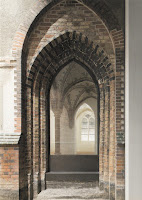On Sunday and Monday I was in Lübeck.
Lübeck is the second largest city of the German State of Schleswig-Holstein. It was once the leading city of the Hanseatic League and is today still Germany's most important port on the Baltic Sea. Since 1987 is the Hanseatic City of Lübeck on the UNESCO World Heritage List.
Niederegger is the most famous producer of Lübeck Marzipan. The company was founded in 1806 and now sells its products all over the World. The Café Niederegger in Lübeck's Old Town offers a shop for Niederegger sweets and a Marzipan Museum on its upper floors.
The Town Hall of Lübeck was built in the style of the Brick Gothic and became the model for other town halls in the Baltic Sea region. It was once the meeting place of the Hanseatic League.
The Holy Spirit Hospital was founded in the 13th century by rich merchants and is thus one of the oldest existing welfare institutions in the World. During the Reformation the abbey-like hospital was transformed into a usual retirement home.
Lübeck is known as City of the Seven Towers, because the seven towers of Lübeck's five main churches shape the city's skyline. The five main churches are the Lübeck Cathedral, the Church of Saint Aegidien, the Church of Saint Peter, Saint Mary's Church and the Church of Saint Jacob.
The Lübeck Cathedral was founded in 1173 by Henry the Lion. First built in the Romanesque style it was converted into a Gothic-style building between 1266 and 1335. During World War II the church was partly destroyed, but was rebuilt until 1982.
Während meines Aufenthaltes in Lübeck hatte ich leider keine Möglichkeit in die Aegidienkirche zu gehen. Falls mir jemand helfen kann, eine Karte dieser Kirche zu bekommen, würde ich mich sehr freuen. ^__^
The Church of Saint Peter was first mentioned in 1170 and in the 15th century it got its modern day appearance. It was badly damaged during World War II, but it was rebuilt until 1987 without restoring the interior. Today it is not used for services anymore.
Saint Mary's Church was built between 1277 and 1351. It is located on the highest point of Lübeck's Old Town and was used as the church of Lübeck's middle classes. The church is of enormous architectural significance, as it is considered to be the mother church of the Brick Gothic. It also has the highest brick vault in the World.
The Church of Saint Jacob was consecrated in 1334. It was the church of the fishermen and seamen and is a part of the Way of Saint James.
The Holsten Gate is one of only two preserved city gates of Lübeck's medieval city fortifications. It was built in the style of the Brick Gothic in 1464. Today is the Holsten Gate a symbol of Lübeck and houses a museum about Lübeck's history.
The Lübeck Museum of Theatre Puppets is a museum about the puppetry in Africa, Asia and Europe and developed from the private collection of Fritz Fey.
The cards I bought at the museum show Chinese Shadow Puppetry (an Intangible Heritage of the UNESCO), a puppet from Gabun, German marionettes, a shadow puppet from India, marionettes from Myanmar, puppets for the Turkish Karagöz (an Intangible Heritage of the UNESCO) and Moomins.
The Willy Brandt House was opened in 2007. It houses an exhibition about the life of Willy Brandt, the former Federal Chancellor and Nobel Prize Winner who was born in Lübeck.
The Buddenbrookhaus was the location of Thomas Mann's novel "Buddenbrooks". Today it houses a museum with two exhibitions, one about the Mann family and one about the novel.
The European Hansemuseum is the World's largest museum about the history of the Hanseatic League. The exhibition is divided between the new building and the historic Burgkloster. The museum was opened in 2015.








































No comments:
Post a Comment